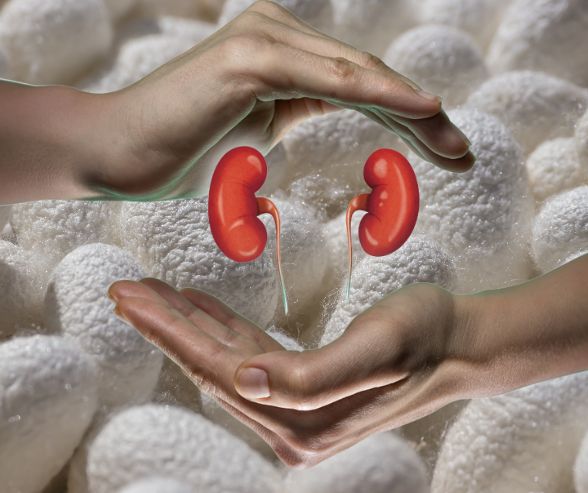Dialysis is a life-saving therapy for millions of patients suffering from chronic kidney failure worldwide. However, we know that the synthetic membranes traditionally used in this process present significant limitations in terms of biocompatibility and selectivity. Scientific research in recent years has turned its attention towards materials of biological origin, identifying silk fibroin as an exceptional candidate for the development of new generation dialytic membranes. Its unique properties of biocompatibility, controlled biodegradability and versatility in processing make it suitable for applications where direct contact with biological fluids requires maximum tolerance from the organism.
The biomaterial with extraordinary properties
Silk fibroin is distinguished by its complex protein structure, characterized by crystalline domains organized in beta sheets alternating with more flexible amorphous regions. This molecular architecture gives the material a unique combination of mechanical strength and flexibility, fundamental properties for the creation of durable and functional dialytic membranes.
From a biocompatibility standpoint, it presents exceptional characteristics. Conducted studies have demonstrated that this biomaterial does not induce significant inflammatory responses when it comes into contact with living tissues, a crucial property for long-term medical applications such as dialysis. Its protein nature, furthermore, favors integration with biological systems, reducing the risk of rejection and complications associated with material incompatibility.
Fibroin's ability to be processed into different morphological forms - from thin films to complex three-dimensional structures - makes it very versatile for manufacturing membranes with specific characteristics. This flexibility in processing allows optimization of porosity, thickness and selectivity of the membrane based on specific clinical needs.
Renal biocompatibility
Renal biocompatibility represents one of the most critical aspects in designing advanced dialytic systems. Conventional membranes, often made with synthetic polymers such as polysulfone and polyethersulfone, can induce inflammatory reactions and complement activation when in prolonged contact with the patient's blood.
Fibroin membranes, instead, have demonstrated superior compatibility with blood components. Various research has highlighted how fibroin surfaces significantly reduce platelet activation and clot formation compared to traditional synthetic materials. This property translates into a reduced need for anticoagulation during dialytic sessions, reducing the risk of hemorrhagic complications for patients.
The interaction of fibroin with plasma proteins furthermore follows more physiological patterns compared to synthetic materials. Fibroin's protein structure facilitates selective absorption of specific proteins that promote biocompatibility, creating a more "natural" interface between the medical device and the patient's biological fluids.
The stability of fibroin in the physiological environment is then a determining factor for dialytic applications. Contrary to what one might think for a material of biological origin, adequately processed fibroin maintains its structural integrity for prolonged periods when exposed to body fluids, guaranteeing consistent performance throughout the membrane's entire life cycle.
Molecular precision in service of purification
Selectivity represents the technological heart of dialytic membranes. The ability to selectively remove uremic toxins while maintaining essential blood components determines the therapeutic efficacy of the treatment. Fibroin membranes offer possibilities for customizing selectivity that exceed those of conventional materials. Their porous structure can be finely modulated through different processing techniques. Electrospinning, for example, allows creation of nanofiber networks with controlled porosity, while phase-inversion techniques permit obtaining asymmetric membranes with porosity gradients optimized for molecular separation.
Membranes of this versatile protein can be designed to obtain specific sieving coefficients for different classes of molecules. The removal of medium molecular weight toxins, such as beta-2-microglobulin, results truly very efficient with these membranes, reducing long-term complications associated with accumulation of these substances in dialyzed patients. The possibility of incorporating specific functional groups into fibroin's structure furthermore opens interesting scenarios for developing "intelligent" membranes. The introduction of domains with specific affinity for certain toxins would allow even more selective and efficient removal, personalizing treatment based on the patient's individual toxemic profile.
Advanced dialysis and personalized therapies
The possibility of modulating membrane properties during the production phase allows adaptation of treatment to each patient's specific clinical needs, an approach that aligns perfectly with precision medicine principles. Fibroin membranes have shown superior performance in removing protein and peptide toxins, often problematic for conventional synthetic membranes. This characteristic is particularly relevant for patients with complex toxemic profiles and with needs for specific clearance for particular categories of molecules.
The durability aspect represents another significant advantage. These membranes have demonstrated superior resistance to fouling (the accumulation of protein and lipid deposits on the surface) compared to conventional membranes. This property translates into more efficient dialytic sessions and the possibility of extending membrane usage duration, with both clinical and economic benefits. Their superior biocompatibility then allows consideration of innovative dialytic modalities, such as more prolonged treatments and at higher blood flows, which could improve purification efficacy without compromising treatment tolerability for the patient.
Biomedical engineering and technological innovation
From a biomedical engineering standpoint, fibroin membranes represent an extremely fertile research field for developing innovative technologies. The possibility of combining biotechnological approaches for fibroin production with advanced nanofabrication techniques opens many paths for creating membranes with increasingly specific and performant properties.
The use of genetic engineering techniques leads to creation of proteins with modified amino acid sequences, optimized for specific dialytic applications. This biotechnological approach overcomes natural fibroin limitations, introducing additional functionalities without compromising the material's intrinsic biocompatibility.
3D printing and microfabrication technologies are furthermore providing the possibility of creating membranes with complex and personalized architectures.
Conclusions
Fibroin membranes for dialysis represent a paradigmatic example of how nature can inspire advanced technological solutions for contemporary medical challenges. The unique combination of biocompatibility, selectivity and processing versatility of this biomaterial manages to show medicine beyond the current boundary, proposing exciting solutions for improving dialytic therapies.
Evolution towards biologically inspired membranes does not simply represent a technological innovation, but a philosophical change in the approach to medical device design. The use of materials that are able to naturally dialogue with biological systems promises to reduce complications associated with dialytic treatments and improve patients' quality of life.


